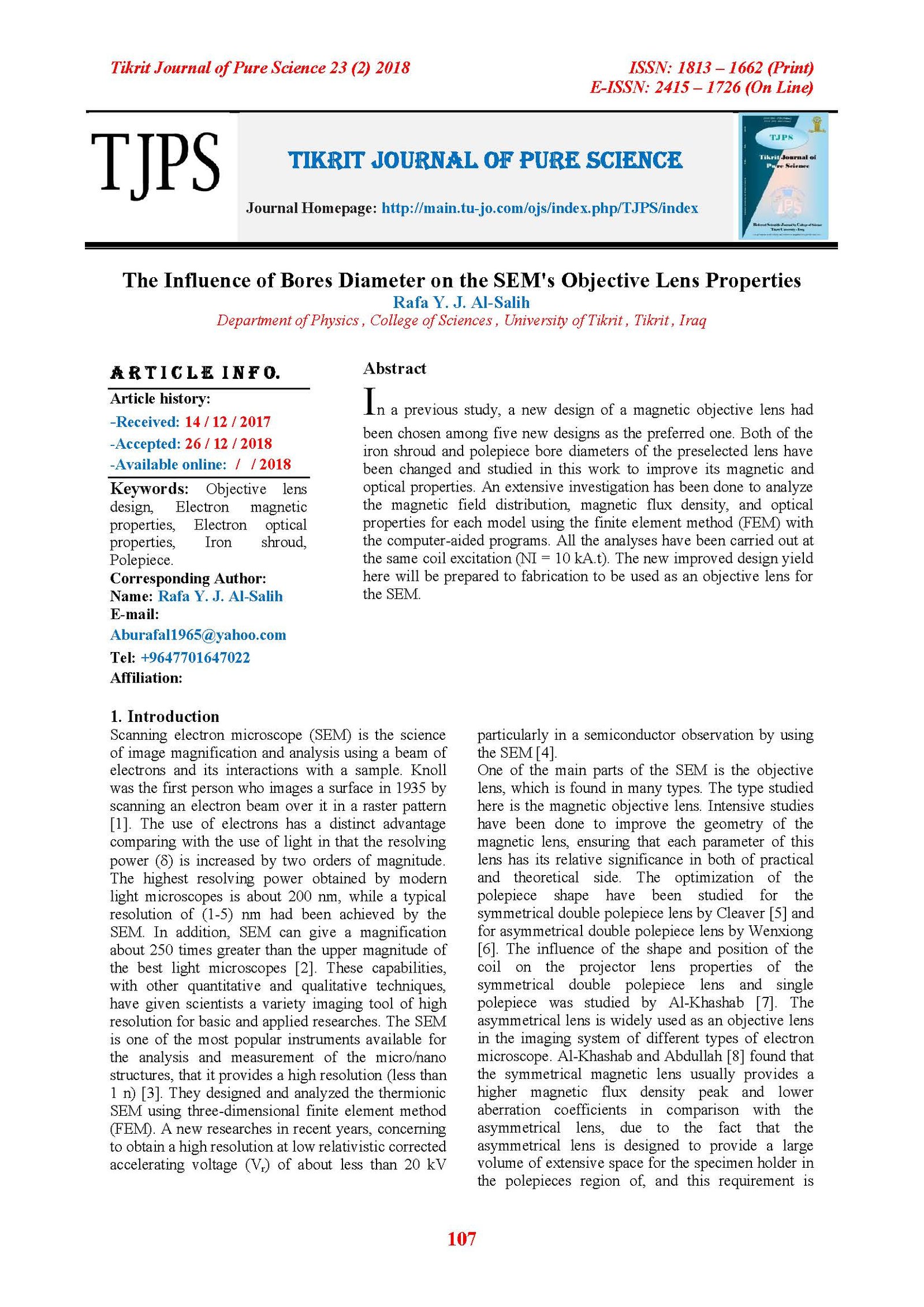The Influence of Bores Diameter on the SEM's Objective Lens Properties
Main Article Content
Abstract
In a previous study, a new design of a magnetic objective lens had been chosen among five new designs as the preferred one. Both of the iron shroud and polepiece bore diameters of the preselected lens have been changed and studied in this work to improve its magnetic and optical properties. An extensive investigation has been done to analyze the magnetic field distribution, magnetic flux density, and optical properties for each model using the finite element method (FEM) with the computer-aided programs. All the analyses have been carried out at the same coil excitation (NI = 10 kA.t). The new improved design yield here will be prepared to fabrication to be used as an objective lens for the SEM.
Article Details

This work is licensed under a Creative Commons Attribution 4.0 International License.
Tikrit Journal of Pure Science is licensed under the Creative Commons Attribution 4.0 International License, which allows users to copy, create extracts, abstracts, and new works from the article, alter and revise the article, and make commercial use of the article (including reuse and/or resale of the article by commercial entities), provided the user gives appropriate credit (with a link to the formal publication through the relevant DOI), provides a link to the license, indicates if changes were made, and the licensor is not represented as endorsing the use made of the work. The authors hold the copyright for their published work on the Tikrit J. Pure Sci. website, while Tikrit J. Pure Sci. is responsible for appreciate citation of their work, which is released under CC-BY-4.0, enabling the unrestricted use, distribution, and reproduction of an article in any medium, provided that the original work is properly cited.
References
[1] Pawley, J., (1997), "The development of field-emission scanning electron microscopy for imaging biological surfaces", Scanning, 19(5): 324-335.
[2] Sampson, A. R., (1996), "Scanning Electron Microscopy", http://www.sem.com/ analytic/sem.htm.
[3] Park, M. J.; Park, K.; Kim, D. H.; and Jang, D. Y., (2008), "Design and analysis of a thermionic SEM column using 3D finite element analysis", Physics Procedia, 1: 199-205.
[4] Yonezawa, A.; Sato, M.; Takaoka, O., (2000), "Electron beam devices", US Patent, No. 6, 037, 589.
[5] Cleaver, J. R. A., (1980), "The effect of the polepiece saturation on the electron optical properties of asymmetrical condenser objective lens", Scanning Microscope, 2(3):1283- 1292.
[6] Wenxiong, C. (1988), "The effect of the polepiece saturation on the electron optical lenses", Scanning microscope, 2(3): 1283- 1292.
[7] Al-Khashab, M. A., (2001), "New development of electron projector lens", Eng. Technology, 20(10): 591- 601.
[8] Al-Khashab, M. A.; Abdullah, A. E., (2006), "The effect of snout shape geometry of the polepiece on the objective lens parameters", Derasat, Pure Sciences, 33(1): 28- 34.
[9] Lenz, F., (1982), "Properties of Electron Lenses", In "Magnetic Electron Lenses", Ed. Hawks, P. W. (Berlin, Springer): 119- 161.
[10] Al-Khashab, M. A.; Ahmad, A. A., (2012), "The influence of electrode angle on the minimization of the aberration coefficients of the two electrodes electrostatic immersion lens", Jordan Journal of Physics,5(2): 67- 75.
[11] Al-Khashab, M. A.; Ahmad, A. A., (2011), "The effect of magnetic lens structure insulation on its
optical performance", Derasat, Pure Sciences, 38(2): 161- 168.
[12] Mulvey, T., (1982), "Magnetic Electron Lens Properties", Ed. Hawks, P. W. (Berlin, Springer): Ch. 5.
[13] Munro, E., (1971), "Computer aided- design method in electron optics", Ph.D. Thesis, University of Cambridge, U. K.
[14] Hussain, S. H., (2012), "A computer aided designing tools for electron lenses", Ph.D. Thesis, University of Al- Mustansiriyah, Iraq, Baghdad.
[15] Al-Khashab, M. A.; Al-Salih, R. Y., (2013), "New design of objective lens geometry for low voltage SEM", Jordan Journal of Physics, 6(2): 87-94.
[16] Al-Khashab, M. A.; Ahmad, A. A., (2004), "Some approaches to the projector lens polepiece geometry and their effect on magnetic flux lines", Derasat, Pure Sciences, 31(1): 22- 29.
[17] Munro, E., (1975), "A set of computer programs for calculating the properties of electron lenses", University of Cambridge, Department of Engineering Report CUED/B- Elect TR45.
[18] Abbass, T. M.; Nasser, B. A., (2012), "Study of the objective focal properties for asymmetrical double polepiece magnetic lens", British Journal of Science, 6(2): 43- 50.
